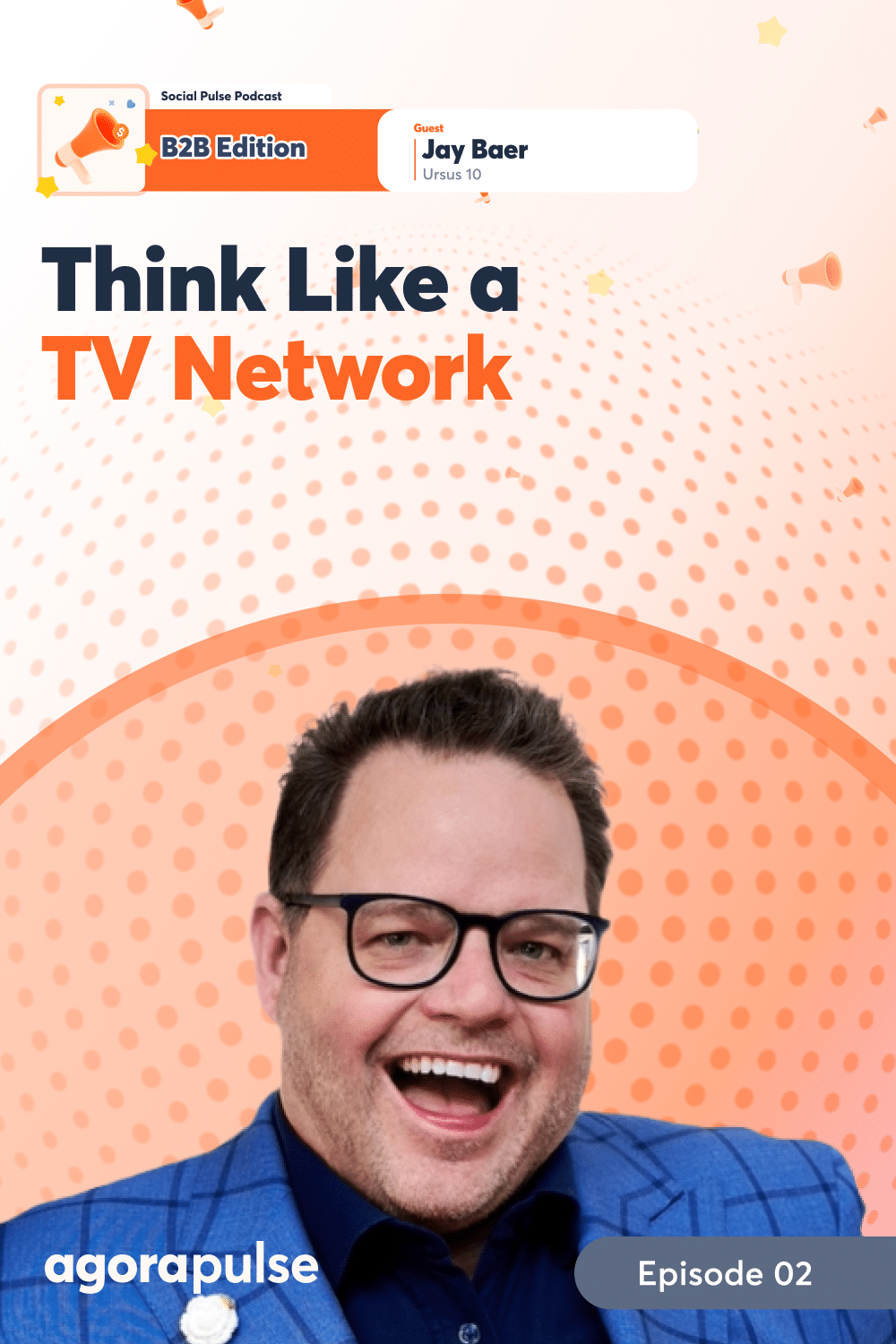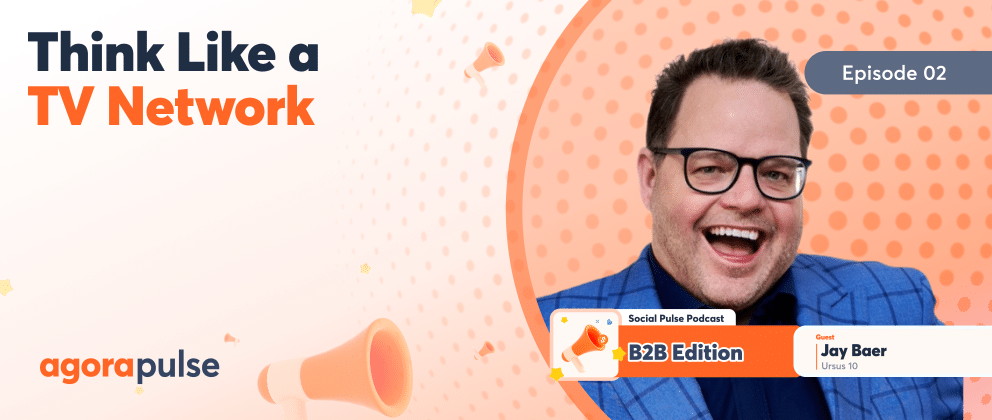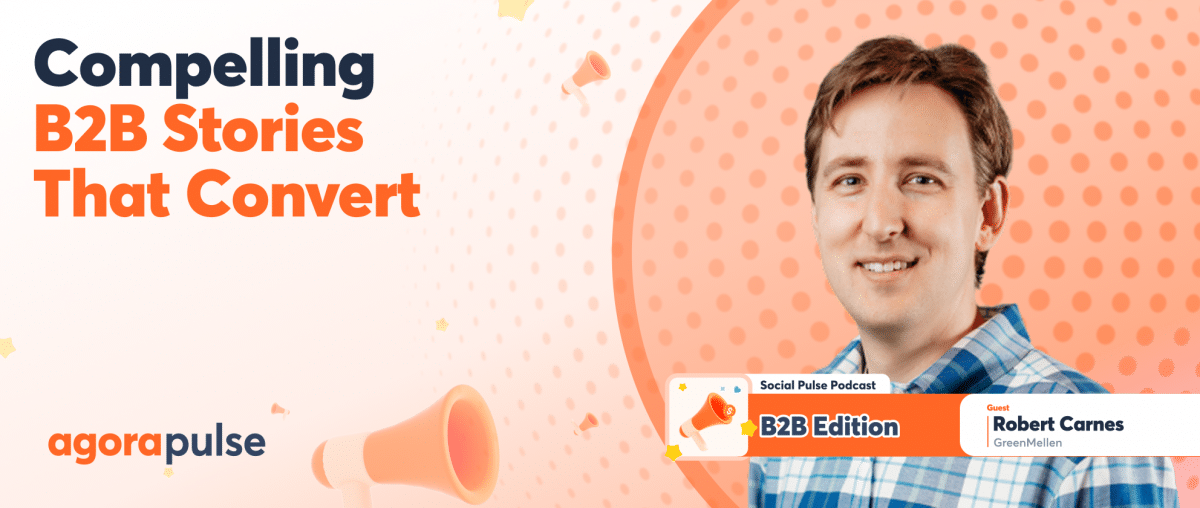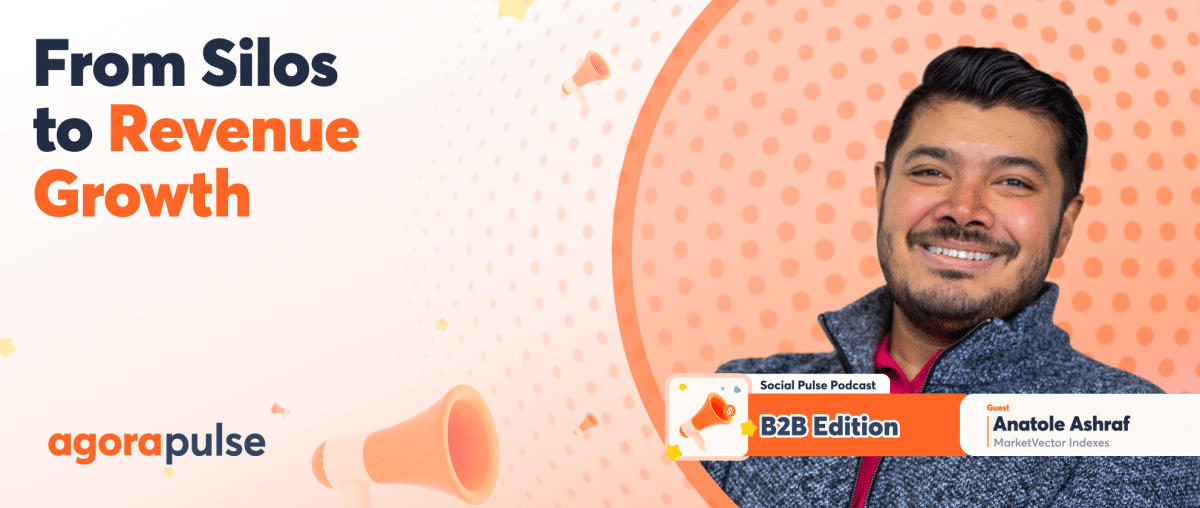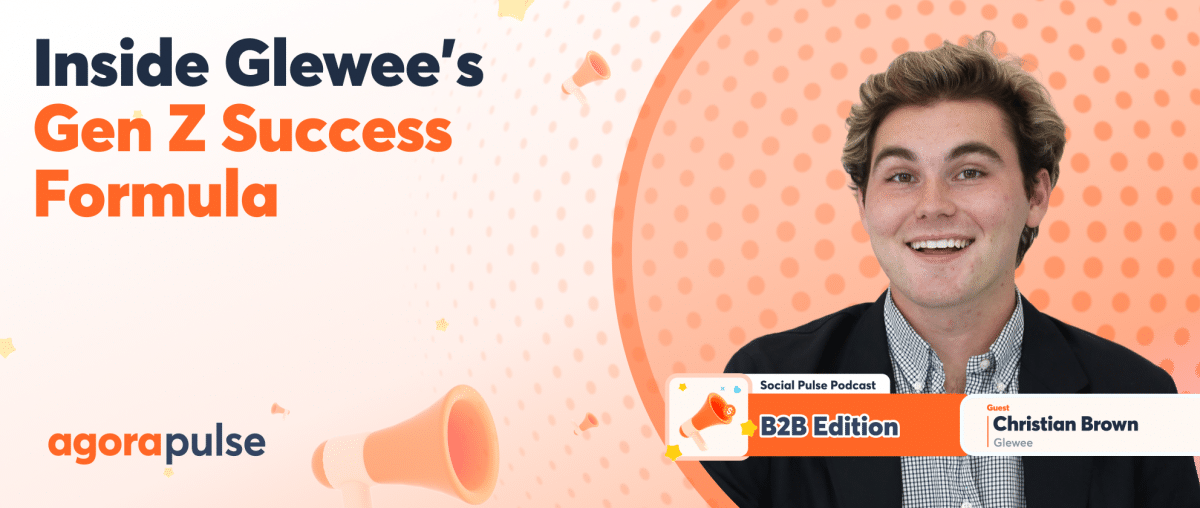Are you struggling to see meaningful results from your B2B social media efforts? Does it feel like your content is just random acts with no cohesive strategy or clear purpose? This is a common challenge for many B2B marketers who wonder what the true point of their social media presence is.
Imagine wasting countless hours creating content that never reaches or resonates with your target audience. Think about the potential clients you’re missing out on because your social media strategy lacks direction. The frustration of low engagement and aimless content can leave you questioning the very purpose of your efforts.
Are you looking for a model that integrates planning, consistency, and purpose—much like a successful TV network?
Our Social Pulse Podcast: B2B guest has the solution.
Listen to the full episode, hosted by Agorapulse’s chief storyteller, Mike Allton, or read on for the recap.
Jay Baer, a renowned business growth and customer experience strategist, is here to discuss his groundbreaking, think-like-a-TV network approach. This methodology has transformed B2B social media strategies for numerous leading organizations by providing them with a structured and impactful way to manage their online presence. Jay is a dynamic keynote speaker, bestselling author, and expert in customer experience and business growth strategies with a rich background that includes this innovative think-like-a-TV network approach pioneered at Convince and Convert. Jay has helped many B2B companies elevate their social media strategies. He’s also the author of several critically acclaimed books, such as Talk Triggers and Hug Your Haters, which provide insightful strategies for creating compelling customer experiences.
B2B Pitfalls
What are some of the biggest pitfalls B2B companies face with their current social media strategies?
Jay Baer: I think there’s a few things.
I mean, you mentioned it at the outset, certainly: random acts of content, random acts of socials. Perhaps the biggest efficiency where people are just putting stuff out there because they feel like it’s something to do.
Or in a lot of B2B organizations, they operate a little bit like higher ed or government, where different folks in the organization, oftentimes in Sales, will say, “Oh, we need to talk about this new product feature, element that we’re rolling out.” It doesn’t have any strategic home, but because it’s new and somebody on the executive team wants to talk about it. It’s got to get sort of plopped down in the middle of the content calendar, like somebody pulling the pin on a grenade and like lobbing it into your calendar. That can be a real challenge.
And then I think fundamentally the biggest problem, Mike, is that in B2B, it seems like a lot of social teams aren’t sure if they’re in the customer acquisition role or the customer retention role. Like, what’s the point of social for this enterprise? Is it to gain new customers out of thin air or to keep the customers we’ve already earned and make sure we keep churn low? Having an answer to that question fundamentally will certainly make your content and social program operate more effectively.
Mike Allton: As someone who’s been with Agorapulse now for over six years—which is very crazy long now, I know, it’s been a long time—and it’s been quite the journey. I’ve been heavily involved in social media throughout a lot of those years. And that’s exactly what we’ve struggled with.
What’s our role in the organization? How are we trying to do more than just take orders from other departments in the company? How are we supposed to approach social media?
I’d love it if you could share what inspired you—for lack of a better word—to think like a TV network.
How did you come up with the TV network approach for B2B social media?
Jay Baer: The team and I at Convince and Convert, when I still ran that organization, were working with several larger B2B organizations. And we were trying to solve a couple of things.
One: this random act of social problem. But two: Convince and Convert is largely a strategy organization, right? Not an agency, not a tactical execution resource.
What would happen is we would come up with a bunch of great plans for B2B brands, and then we’d say, “Here’s the plan,” but then they have to execute it, right? So we were writing recipes, and somebody else had to cook the meal.
The challenge is sometimes that it gets lost in translation. You can have a lot of great cookbooks, but unless you know how to julienne a carrot, that recipe ain’t going to turn out just right.
So we were like, okay, we need to add more meat on the bone—to continue my tortured food analogy—and we need to give our clients an actual repeatable framework that they can then use to execute and create an ongoing successful social and content program.
And so we were just riffing—I think I don’t remember exactly where we came up with this. I think it was at one of our annual company meetings. We used to always meet every year in Puerto Vallarta, Mexico, and the whole company would stay together in a large house. And so we are in the pool and were probably more than one margarita into it.
“We needed a scheme, we needed a framework, we needed some kind of a thesis, and we were just talking about how other types of media sort of execute on content.
And we landed on this TV network approach: If you turn on Discovery Channel or something, they have the same shows every Thursday, every Wednesday, and every Tuesday. Same thing with ABC, NBC, or any other network. It’s not random, right? They have a TV guide that tells you when things are going to be on.
And so we realized: Some measure of consistency in how you’re going about social is really how humans have been trained.”
If you use a different analogy, imagine that you were a subscriber to Sports Illustrated magazine back when people still had printed magazines named Sports Illustrated. But imagine at one point [when] Sports Illustrated was either the first or second largest magazine in the United States. Imagine one week it would come out on Thursdays. I know that from when I was a kid. One Thursday, you get the magazine, and indeed it’s about sports, and the next Thursday you get the magazine, and it’s about science. And two weeks from now, it’s about food, and three weeks from now, it’s about interior design. You’re like, “What the hell is going on with this magazine? I don’t understand what this is about. I’m very confused.”
And that is exactly how a lot of B2B social media programs look to the people who are supposed to be engaging with that content. So the TV network approach was let’s make it consistent.
Then we built three different content types to help articulate this strategy.
3 Types of Content Types
People are using ICPs more often, which is great, but in many cases, my experience has been that it doesn’t get applied to social. The ICP gets looked at in the larger marketing construct, maybe in a content marketing case, but in terms of actual social, a lot of times, the ICP just goes out the window, which is a real shame.
The three types of programming that we came up with in this think-like-a-TV-network approach are these:
- You have to have news and updates. So this is your social media flotsam and jetsam. These are the things that happen regularly, a new feature testimonial. It’s the kind of things that happen regularly. They’re not going to be showstoppers. Not everything’s a banger, right? We know this is social, but it’s the things that you have to execute—those sort of fill out the content calendar.
- The second type of content is episodic content, just like we are creating right now. It’s something that happens regularly. It could be weekly, could be daily, could be monthly, could be quarterly. Probably weekly-ish is usually what we would think about. And it happens in the same format with the same personalities targeted to the same ICPs and promoted in the same channels. It is appointment viewing. Again, back in the day, when we watched a lot of network TV, Cheers was always on right at eight o’clock on Thursdays. It wasn’t like eight o’clock on Thursdays, and the next week it’s nine o’clock on Tuesdays that used to happen to a lot of shows in the pre-streaming era and it was death. If your time slot got changed in the network TV era, you were screwed. Like, that was it because people couldn’t find it anymore. So we have to have that same kind of consistency with our social approach.
- And then the third content type is special events. So this is your Oscars, your Tonys, your Grammys, your whatever. This is the big thing that you lean into. Maybe it’s a virtual summit. Maybe it’s some kind of a livestream. You know, it’s the thing that you don’t do all the time. You might do it every 60 days, every 90 days, every 45 days, or something—but it transcends the regular content approach. And it’s the thing that you use primarily to de-anonymize the audience. It’s the thing that’s big enough that people will say, “It’s okay if you know who I am because I want access to this special thing.”
Are there any other components that we should be keeping in mind when we’re trying to build this out? And how do some of these components differ, do you think, from what we might call traditional social media strategies?
Jay Baer: I think the traditional strategies oftentimes will focus first on the news and updates. Like, we got to say this thing and then this thing, and then it becomes very staccato and not consistent. And then, when permissible, “Oh, yeah, we should talk about the podcast. Oh, yeah, we should talk about the live stream.”
Our philosophy should do the exact opposite.
So you take a social calendar and say the first thing you plot out are the special events, the big tentpole pieces, the Grammys, the Tonys, and the Oscars because that’s going to have teasers. It’s going to have post-broadcast elements as well. So, you put those on the content calendar first.
Then the second thing you put in is the episodic content. The podcast, the weekly Tiktok, whatever the circumstances are—that’s the second piece.
And then you fill in with the third type: the regular news that updates, which is the exact opposite of how most people build out a social calendar.
Mike Allton: I have seen that firsthand. I know exactly what you’re talking about because then it becomes doing it the wrong way around. And now they’re struggling to promote the big thing, the most important thing.
Jay Baer: You got to fit it in somehow. You have to shoehorn it in somehow. You put all this effort into this big thing, and then you realize, “Oh, we don’t have enough room in the calendar to promote it sufficiently, right?”
Now, what this does require, though, let me just acknowledge what this does require is having your sh*t together a lot further out than most people do. You got to be like, “Okay, we’re going to do this big livestream in five months, and therefore we got to put that on the calendar and then work backward to make this all work.”
I just want to acknowledge that not everybody can do that, or wants to do that, or for whatever reason can do that. But, yes, this does require some longer-term visibility into what you’re doing. And I do want to just acknowledge that that can be a luxury in some B2B organizations.
Mike Allton: Yeah. But the beauty of having a framework is that now you know what to look for and what to plan out, right? And you’re not trying to scramble or guess, “What are we going to post today?” Because, to your earlier point, “Well, we can’t maybe post it in a week. So we’ve got to fix that.”
We’re doing tentpole events, and we’re learning about our audience there because they’re registering.
How else can we learn about, identify, and understand our target audiences better using this approach to social media?
Jay Baer: I think the first thing is, as we talked about earlier, to identify who you want the audience to be beforehand.
Take your ideal customer profiles, map them against these three social content types, and say, all right, this is why we’re doing this to tickle the fancy of this particular ICP or that ICP. Knowing from the beginning what you’re trying to accomplish—what will make this better? And, certainly, it’s easier to de-anonymize the audience for a big tentpole event. They want to register for the webinar, the live stream, the whatever, for sure.
But even episodic content—you can use that very effectively to gather data and build some attribution modeling if you just build it into the show, right?
Think about a podcast. I used to host the Social Pros Podcast for many, many, many years, and we would routinely build hooks into that show that said if you want to download an ebook of the last 20 guests, we had on the show and the most interesting quote from each of them, just go here. And so we would use those kinds of longer-form content assets to backstop shorter-form episodic content so that we’re gathering more and more data and understanding how this is working for sales velocity for net new leads, all those kinds of things.
Consistent Programming in Strategy
Mike Allton: One of the really interesting subtexts here is if we’re creating episodic content, to your point earlier, the same talent and personality consistently—I’m hosting this show, you hosted Social Pros, which that means we’re doing it for a while. That suggests we’re being consistent with the programming.
How do you see that playing into the success of this overall strategy?
Jay Baer: Our rule when we were working with clients on this when I was at Convince And Convert is it’s six months or let’s not bother. If you’re going to create an episodic content execution, you’ve got to give it six months or don’t even bother.
“It’s like any other form of media: You’ve got to let the audience find it. Or you’re not giving the audience sufficient chance to discover it, tune in, and make it part of their actual habit and routine.”
If you can’t give yourself enough leeway to let it find its sea legs, you’re dooming it to failure before you ever even get started.
Six-month minimum commitment is what I’d say.
Metrics to Know If How Your Show is Going
Mike Allton: When you’ve done these shows or you’ve seen your clients work on episodic content like we’re talking about, what kinds of engagement views/success metrics have you seen that would say, “This show’s going well, it’s on the right track,” or “It’s been five or six months; this show only has this level of X amount of time to kill it?”
Where are you standing on that?
Jay Baer: The nice thing about B2B is it’s not necessarily about the number of people who consume the content; it’s whether it’s the right people. It is actual customers and prospects, and those are different things.
If it’s actual customers, then when those people are up for renewal, one of the things I would want to build into my CRM is, “Okay, we’re asking this organization to renew their SaaS license. By the way, have you tuned into our podcast or our episodic video series?” And you just flag that in the CRM and then run an analysis to say, what’s the delta between people who renew versus people who don’t renew and the likelihood that they consume the content?
That’s really important information. Now, is that causation? Is somebody going to give you money for software because you have a YouTube show? Not likely, but there’s a correlation there for sure. So it’s those analytics that can justify this episodic content.
But I’ll tell you, Mike, the most important thing is to figure out how you’re going to measure it before you start making the show. I could do two hours on this topic alone. This idea of, “Hey, we made 24 of these things. How’s it working?” Man, that is a difficult analytics challenge and can create a lot of hurt feelings and hard conversations because you are essentially doing the math version of pinstriping a moving vehicle.
It’s possible. It is possible to do that, but the results will be less than satisfactory.
The Uncertainty of Streaming
Mike Allton: So Jay, if we’re a TV network—say NBC or even like a Netflix, a streaming network—we’re almost constantly changing lineups and programming shows are being added and dropped and reruns are being shown or not Netflix is adding or removing content from their library all the time.
How would a B2B company curate their social content that would align with that kind of behavior?
Jay Baer: I think fairly similarly—although I don’t know that we would want to change approaches too quickly.
As we talked about, you’ve got to give the audience time to find the show, especially the episodic content, and make sure that they can tune in or whatever that means in that particular execution.
I will say [that] this idea of reruns is an important point. I find that most B2B social organizations are loathe to repeat themselves. “We did a piece of content about that a year ago.” Yeah, bro. Nobody remembers that other than you because all you think about is the social content from this one company.
The audience forgot that the day after you published it.
The atomic half-life of a piece of social content is hours, not months, and certainly not years. And so this idea of taking things that worked in the past, re-swizzling them, and putting them out again is something that is underutilized by most teams.
We do it in my tequila account, Tequila Jay Baer. We’ll take videos that were disproportionately successful and a couple of months later, we just recut them and publish them again. And it works every time because nobody other than you and your mom is seeing every piece of content you publish. It’s just not practical.
Mike Allton: Terrific advice. Couldn’t agree more. And “re-swizzle”—we’re going to put that into the glossary, as I love that.
Success Stories from B2Bs Like You
Let’s get into some examples so people understand the kind of work that we’re talking about.
Maybe you could share some B2B companies you’ve worked with where you’ve seen them implement this approach.
Jay Baer: A lot of them I can’t talk about because it’s all NDA stuff, of course. One of them that I like a lot is Corteva, the very large agro-sciences company.
One of their brands is Pioneer, which is the largest brand of corn seed, right? So they’re selling to big farmers, commercial farmers, etc. And you think, “Oh, wow. What’s the content approach for a seed company? There’s a challenge.”
They do an amazing job. They have this great episodic program, called the Epperson’s, which is literally like a documentary-style YouTube show about a family of farmers, the Epperson’s. And it’s about them and their kids and their crops. And I think they’re in Iowa, and it’s just their life. It’s like a show you would watch on Netflix, but it’s about the epicenter. There’s light product placement, but it’s great. People love it. They’re compelling characters. That’s sort of their day-to-day. It’s weekly, I think, episodic content.
Then they have the big tent poles where they either have a big live stream with one of their agro-science people or big new research reports on different strains of corn and fertilizers, etc. And everybody shows up for that because if you’re in that business, that’s really important information to know. So they’re doing that on a maybe every 45, every 60-day basis.
And then every week on Facebook in particular—I love this one. So this is episodic content but with the sort of the production of news and updates, right? It’s not a heavy lift, it’s a light lift, but they do it consistently. It’s farm dogs. So every Friday on Facebook, here’s another farm dog. And people love it because farmers like farm dogs, right? And so that content goes: People submit dog photos. I want to be the farm dog of the week, etc. So smart, and I think a good example of how this TV network strategy works in practice.
What would you say are the major benefits that are for companies that want to adopt this kind of approach, what can they expect to achieve?
Jay Baer: I think it’s a more efficient use of your resources because once you have a calendar with different show types mapped to ICPs, you’re not firing bullets off into the air hoping that a bird flies over simultaneously. So you’re not wasting as many motions internally. It’s more efficient to use your resources.
If you do it well, you’re going to get better engagement and better results from the ICPs that you care about. So whatever that means, more subscriptions, more comments, more likes, more shares, more, all the things that matter and then especially insofar as the lighter weight content leads people to be part of the programming of the special event, it’s going to de-anonymize the audience at a higher rate than it would ordinarily, which then gives you better analytics to tie your marketing efforts back to actual revenue.
Because, again, let’s remember at the end of the day, marketing has to pay their way. This isn’t arts and crafts. This isn’t about making people love us for the sake of loving us. Marketing has to pay its way. And the more that you can prove that mathematically and analytically, the better off you’ll be. And the more the C suite will love you.
Mike Allton: Everybody go back and [read] that segment again because that was amazing.
You’re talking about metrics, and we touched on that earlier, but I want to bring it home with that because it’s incredibly important. Particularly today with budgets tightening, folks need to be able to show the value that they’re bringing to the business, and they need to be able to speak that language to the C suite to the CFO increasingly more than I think than ever before.
Measuring Success/ROI
How do you suggest marketers go about measuring the success of these kinds of activities, particularly on social media when they’re implementing this kind of approach?
Jay Baer: We touched on a little bit earlier. I think the key is to, before you get into this at all say, what are we as a marketing department truly going to be judged on?
And that sounds obvious, but it’s not because especially in B2B different marketing teams are held to a different standard depending on what is valued inside that organization.
Is it a contribution to the pipeline? Is it sales velocity? So deals are closing more quickly. Is it creating new opportunities that didn’t exist before and turning those opportunities over to sales? You were essentially almost a BDR for the sales team as part of the marketing function. Is it churn reduction and retention?
All of those are valid mathematical justifications for marketing spend, but they’re very different.
And as a professional marketer, before I do anything, I want to know from whoever is signing my check, which of those things—or maybe some other ones—do they care about? Because, for sure, I will then build a program that emphasizes those things as opposed to build a program that I think is cool, and let’s hope that that achieves the goals that we want it to.
That’s all the time we’ve got for today, friends, but don’t forget to find the Social Pulse Podcast: B2B Edition on Apple and leave us a review. We’d love to know what you think. Until next time.
